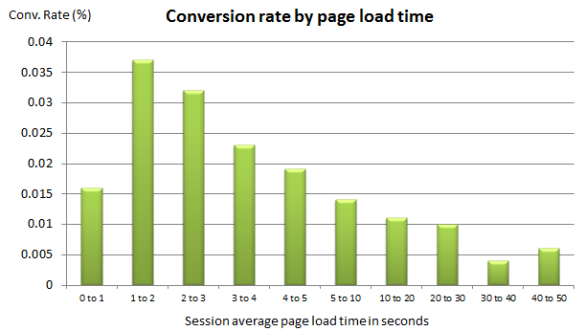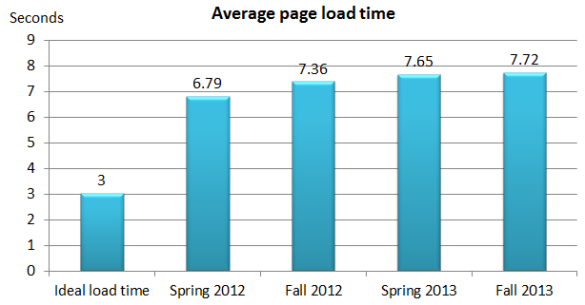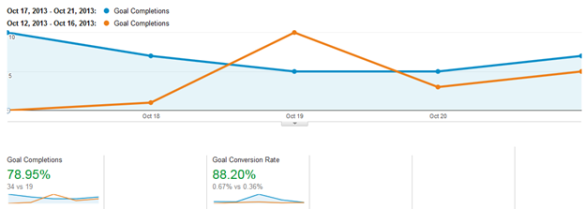When was the last time you abandoned a website because it took too long to load?
In 2006, 40% of online shoppers were abandoning a website if it took more than four seconds to load. In today’s fast paced world, people expect a website to load in two seconds or less. That’s right. 2 seconds.
According to Amazon.com, for every one second delay, conversions will drop by 7%. That’s a $2.5 million loss per year if you sell $100,000 per day.
A study by Akamai in 2009 surveyed more than 1,000 online shoppers and found that more than 47% of people expect a web page in load in two seconds or less. The research also found that speed impacts customer loyalty with:
- 52% claim that a quick page load is important to the loyalty of the website
- 64% who are not happy with the site will shop at a competitor
- 79% are less likely to return to the website
A slow website not only affects your online sales, but 27% are also less likely to shop at the sites physical store.
In 2010, Gomez interviewed more than 1,500 online shoppers in their “Why Web Performance Matters” report. One of the biggest findings from the Gomez report was that more than two-thirds told others about a disappointing web experience.
A slow website will lead to you losing business online and offline and customers will shop elsewhere
Site speed improves SEO
Another important aspect to site speed is SEO (search engine optimization). A slow website not only provides a poor user experience, but will also get your website penalized in the search results.
Site speed became a focus to search engine ranking factors in 2009, which came from a usability test that both Google and Bing conducted to determine the impact of a slower search results page.
In their study, Google found that by slowing page speed down from 100 to 400 milliseconds. the number of searches per user decreased over a four to six weeks period.
Bing’s study had a measureable impact on clicks and revenue by delaying the search results by two seconds. Bing found that the two delay decreased revenue by 4.3% per visitor. With more than 48 million monthly visitors, that’s a huge loss.
Websites are getting slower
Eight years ago, Amazon announced that for every 100ms of website speed improvement, they saw a 1% increase in revenue. Yet for the leading eCommerce sites, websites are getting slower.
In just over eighteen months, studies* have revealed that of the top 500 retailers:
- Only 8% use image compression
- The average page load time is 7.72 seconds
- Sites are 13.7% slower compared to 2012
* Studies using Google Chrome browser
In order to fix your site speed issues, there are a number of tools you can use. Here are three of the best tools you can use to test your site speed:
Google’s PageSpeed Insights tool provides recommendations on what you can do in order to make your site faster. The most common problems experienced are browser caching, un-optimized images and minifying JavaScript/ CSS.
Impact of making your site faster
Prioritizing site speed improvements is challenging.But there are ways to increase site speed, or perceived site speed. One way to get internal buy-in is to run your competitor websites through the WebPageTest tool and using the ‘create video’ function.
SuperOffice compared their site speed with SalesForce, Zoho and Sugar CRM. The test discovered that SuperOffice’s competitor sites were loading in just over two seconds, whereas SuperOffice took 12.8 seconds to load.
By watching the video comparison, SuperOffice could see that the flash was taking a long time to load. As a result, the flash banner was removed from the home page and a new video test was created, comparing SuperOffice websites – One website without flash and three websites with flash.
The second video test found that:
- Page load speed WITH flash = 11 seconds
- Page load speed WITHOUT flash – 2.7 seconds
This means that by removing the flash banner, the website speed improved by 10 seconds.
Their website now loads faster, which delivers a greater user experience. But how does this impact conversion rates?
SuperOffice compared the changes five days after the change with the five days prior to the change.
The result was that conversion rate increased by 88%, from 0.36% to 0.67% and goal completions increased by 78%, from 19 to 34.
During the comparison period, overall web traffic decreased by 4% and no other marketing activities were launched. The only change documented was the improvement to site speed.
Make site speed a priority
A slow website will negatively impact your business, and website users expect your site load within two seconds. A fast website is no longer a luxury or a nice-to-have. It’s expected. And by keeping a slow website, your customers will turn to the competition.
Here are five steps you can take to make sure your website loads faster:
- Use the conversion loss calculator to estimate how much revenue you are losing
- Use the WebPageTest tool to compare your site speed against your competitors
- Send these results to the senior management or CEO to make site speed a priority
Once you have been given the go ahead to improve site speed performance, you can:
- Run your most visited 10/25/50 pages through a site speed tool to identify load time issues
- Have your IT team fix the problems immediately
Once your page speed issues have been fixed, you can then monitor the improve to your conversion rates.
Looking for More Conversion Rate Optimization Tools?
I’ve created a list of 18 Conversion Rate Optimization tools that every CRO experts needs to boost conversion rates.
And I’m sharing them with you, for free.
Access the tools below.


